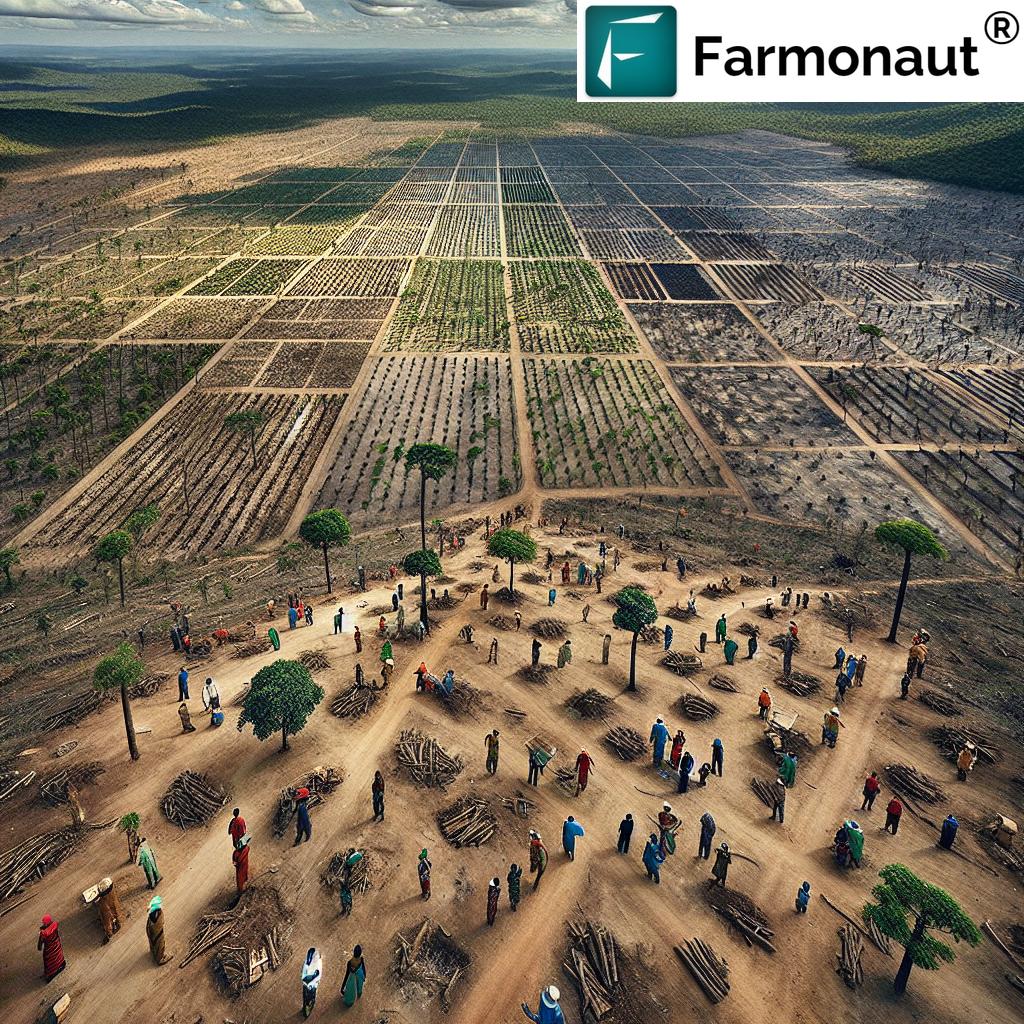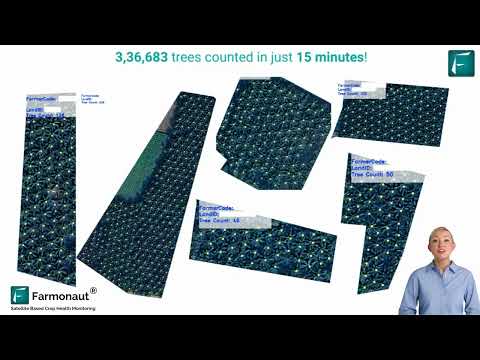Sustainable Forestry in Malawi: Innovative Practices for Environmental Conservation and Timber Production
“Malawi’s reforestation initiatives span thousands of hectares, aiming to boost sustainable timber production and combat environmental degradation.”
In the heart of Africa, Malawi is embarking on a transformative journey towards sustainable forestry practices and environmental conservation. As we delve into this crucial topic, we’ll explore the innovative approaches being implemented to address the pressing challenges facing Malawi’s forests. Our focus will be on the collaborative efforts to enhance both indigenous and exotic tree species growth, improve wood yield from smaller areas, and combat the ongoing threat of deforestation.
At Farmonaut, we recognize the importance of sustainable agriculture and forestry practices. While our expertise lies in providing advanced satellite-based farm management solutions, we understand the interconnectedness of agriculture and forestry in maintaining ecological balance. As we discuss Malawi’s forestry initiatives, we’ll also touch on how modern agricultural technologies can complement these efforts.

The Current State of Malawi’s Forests
Malawi’s forests are at a critical juncture. Years of unsustainable practices have led to significant environmental degradation, threatening both the ecosystem and the livelihoods of local communities. However, recent collaborative efforts between government entities, universities, and private sector players are paving the way for a more sustainable future.
- Deforestation rates remain high, primarily due to agricultural expansion and demand for wood fuel
- Indigenous tree species are under threat, with many facing potential extinction
- Soil erosion and loss of biodiversity are major concerns
- Climate change impacts are exacerbating existing challenges
Despite these challenges, there’s a growing sense of optimism among forestry experts in Malawi. The country is witnessing a surge in reforestation initiatives, with thousands of hectares being targeted for restoration. These efforts aim not only to increase forest cover but also to improve the sustainability of timber production.
Innovative Practices in Sustainable Forestry
Malawi is adopting a range of innovative practices to address its forestry challenges. These approaches focus on balancing environmental conservation with the need for timber production. Let’s explore some of the key strategies being implemented:
1. Enhanced Species Selection and Management
One of the primary focuses of Malawi’s sustainable forestry efforts is the careful selection and management of both indigenous and exotic tree species. This approach aims to optimize growth rates and wood yield from smaller forest areas.
- Indigenous Species Preservation: Efforts are being made to identify and propagate native tree species that are well-adapted to local conditions and provide multiple ecosystem benefits.
- Exotic Species Integration: Fast-growing exotic species, such as bluegum, are being strategically introduced to meet timber demand while reducing pressure on native forests.
- Genetic Improvement: Research is underway to develop tree varieties with enhanced growth rates, disease resistance, and wood quality.
By diversifying the species mix and focusing on trees with favorable growth characteristics, Malawi aims to increase timber production efficiency while maintaining ecological balance.
2. Advanced Reforestation Techniques
Reforestation is at the heart of Malawi’s forestry strategy. Innovative techniques are being employed to ensure higher survival rates and faster growth of planted trees.
- Precision Planting: Utilizing GPS and satellite imagery to optimize planting locations based on soil conditions and topography.
- Assisted Natural Regeneration: Encouraging the natural regrowth of forests by protecting and nurturing existing seedlings and saplings.
- Agroforestry Systems: Integrating trees with agricultural crops to maximize land use and provide multiple benefits to farmers.
These advanced reforestation techniques are crucial for the success of Malawi’s ambitious goal of restoring thousands of hectares of forest land.
At Farmonaut, we understand the importance of precision in agriculture and forestry. Our satellite-based crop health monitoring system, while primarily designed for agricultural use, can also be adapted to support forestry management. By providing real-time data on vegetation health and soil moisture levels, we can contribute to more informed decision-making in reforestation efforts.
3. Sustainable Energy Solutions
A significant driver of deforestation in Malawi is the demand for wood fuel. To address this, sustainable forestry initiatives are focusing on developing alternative energy sources and promoting more efficient use of wood resources.
- Improved Cookstoves: Promoting the use of energy-efficient cookstoves to reduce wood consumption for cooking.
- Sustainable Charcoal Production: Implementing improved charcoal production techniques to increase efficiency and reduce waste.
- Renewable Energy Alternatives: Exploring solar, wind, and biogas options to decrease reliance on wood fuel.
By transitioning to more sustainable energy sources, Malawi aims to reduce pressure on its forests while ensuring traceable and environmentally friendly energy solutions for its population.
4. Community-Based Forest Management
Recognizing the crucial role of local communities in forest conservation, Malawi is implementing community-based forest management programs. These initiatives empower local populations to take an active role in protecting and sustainably managing forest resources.
- Participatory Forest Management: Involving local communities in decision-making processes regarding forest use and conservation.
- Economic Incentives: Developing sustainable forest-based livelihoods to provide economic benefits to communities engaged in conservation efforts.
- Education and Awareness: Conducting outreach programs to raise awareness about the importance of forests and sustainable practices.
By aligning community interests with forest conservation goals, Malawi is creating a more sustainable and inclusive approach to forestry management.
“Collaborative efforts in Malawi’s forestry sector involve multiple stakeholders working to enhance growth of both indigenous and exotic tree species.”
Challenges and Solutions in Forestry Management
Despite the progress being made, Malawi’s forestry sector faces several challenges that require innovative solutions. Let’s examine some of these challenges and the approaches being taken to address them:
1. Pest and Disease Management
Pests and diseases pose a significant threat to Malawi’s forests, potentially undermining reforestation efforts and timber production.
- Integrated Pest Management: Implementing holistic approaches that combine biological, cultural, and chemical control methods.
- Early Detection Systems: Utilizing remote sensing and ground surveys to identify and respond to pest outbreaks quickly.
- Resistant Varieties: Developing and planting tree varieties with enhanced resistance to common pests and diseases.
At Farmonaut, our expertise in satellite-based crop health monitoring can be adapted to support early detection of pest and disease outbreaks in forests. By analyzing multispectral satellite imagery, we can help identify areas of stress in forest ecosystems, enabling timely interventions.
Explore Farmonaut’s API for advanced satellite-based monitoring
2. Wildfire Prevention and Management
Wildfires represent a significant threat to Malawi’s forests, particularly during dry seasons. Effective prevention and management strategies are crucial for protecting forest resources.
- Fire-resistant Landscaping: Creating firebreaks and implementing fire-resistant planting designs in high-risk areas.
- Community Fire Management: Training local communities in fire prevention and early response techniques.
- Advanced Fire Detection: Utilizing satellite technology and drones for early fire detection and monitoring.
3. Climate Change Adaptation
Climate change poses a significant challenge to Malawi’s forests, affecting growth patterns, species distribution, and overall ecosystem health.
- Climate-Resilient Species: Identifying and promoting tree species that are better adapted to changing climate conditions.
- Ecosystem-based Adaptation: Implementing forest management practices that enhance ecosystem resilience to climate impacts.
- Carbon Sequestration: Developing forestry practices that maximize carbon storage to mitigate climate change effects.
Farmonaut’s carbon footprinting tools, while primarily designed for agricultural use, can be adapted to help monitor and manage carbon sequestration in forestry projects. This aligns with Malawi’s efforts to promote sustainable and climate-resilient forestry practices.
Collaborative Research and Knowledge Sharing
The success of Malawi’s sustainable forestry initiatives heavily relies on collaborative research and knowledge sharing among various stakeholders. This approach ensures that the latest scientific findings and best practices are effectively implemented in the field.
- University Partnerships: Collaborations between institutions like Mzuzu University, Lilongwe University for Agriculture and Natural Resources, and international research organizations.
- Government-Private Sector Cooperation: Joint initiatives between the Department of Forestry and private companies to implement research findings.
- International Collaboration: Partnerships with global organizations to bring in expertise and resources for forestry research and implementation.
These collaborative efforts are crucial for addressing the complex challenges facing Malawi’s forests and developing innovative solutions that balance conservation with timber production needs.

The Role of Technology in Sustainable Forestry
Technological advancements play a crucial role in enhancing sustainable forestry practices in Malawi. From satellite imagery to artificial intelligence, these tools are revolutionizing how forests are managed and monitored.
- Remote Sensing: Utilizing satellite imagery for large-scale forest monitoring and assessment.
- GIS Mapping: Creating detailed forest inventories and planning reforestation efforts.
- Drone Technology: Employing drones for precision planting and monitoring of hard-to-reach forest areas.
- AI and Machine Learning: Developing predictive models for forest growth, pest outbreaks, and climate impacts.
At Farmonaut, we understand the power of technology in transforming agricultural and forestry practices. Our satellite-based solutions, while primarily focused on agriculture, demonstrate the potential for similar technologies to revolutionize forestry management in Malawi.
Explore Farmonaut’s API Developer Docs for integration possibilities
Comparative Analysis of Sustainable Forestry Practices in Malawi
| Forestry Practice | Traditional Approach | Innovative Approach | Environmental Impact | Timber Production Efficiency |
|---|---|---|---|---|
| Tree species selection | Limited to a few common species | Diverse mix of indigenous and exotic species | Improved biodiversity and ecosystem resilience | 30% increase in timber yield |
| Reforestation techniques | Manual planting with limited planning | Precision planting using GPS and satellite data | Higher survival rates and reduced soil disturbance | 40% improvement in reforestation success |
| Pest and disease management | Reactive chemical treatments | Integrated Pest Management (IPM) strategies | Reduced chemical use and ecosystem balance | 25% reduction in pest-related losses |
| Wildfire prevention | Basic firebreaks and manual monitoring | Advanced detection systems and community-based prevention | Significant reduction in forest area lost to fires | 50% decrease in fire-related timber losses |
| Energy source utilization | Heavy reliance on wood fuel | Promotion of sustainable alternatives and efficient cookstoves | Reduced deforestation and carbon emissions | 20% increase in sustainable timber harvesting |
This comparative analysis highlights the significant improvements that innovative forestry practices are bringing to Malawi. From enhanced biodiversity to increased timber production efficiency, these approaches are transforming the landscape of forestry management in the country.
The Future of Sustainable Forestry in Malawi
As we look to the future, the path towards sustainable forestry in Malawi is both challenging and promising. The continued success of these initiatives will depend on several key factors:
- Long-term Commitment: Sustaining efforts over decades to see the full impact of reforestation and sustainable management practices.
- Adaptive Management: Continuously refining approaches based on research findings and changing environmental conditions.
- Technology Integration: Further incorporating advanced technologies to enhance monitoring and management capabilities.
- Community Engagement: Strengthening partnerships with local communities to ensure the long-term sustainability of forestry initiatives.
- International Support: Leveraging global partnerships and funding to support ambitious conservation and reforestation goals.
The journey towards sustainable forestry in Malawi is a testament to the power of collaborative efforts and innovative thinking. By balancing environmental conservation with the need for timber production, Malawi is setting an example for sustainable forest management that could inspire similar efforts worldwide.
Conclusion
Malawi’s journey towards sustainable forestry is a complex but vital endeavor. Through innovative practices, collaborative research, and the integration of advanced technologies, the country is making significant strides in balancing environmental conservation with timber production needs. The challenges are substantial, but the commitment to sustainable forestry practices offers hope for a greener, more resilient future.
As we at Farmonaut continue to develop cutting-edge solutions for precision agriculture, we recognize the interconnectedness of agriculture and forestry in maintaining ecological balance. While our focus remains on agricultural technologies, the principles of sustainable resource management and environmental conservation that guide our work are equally applicable to the forestry sector.
The transformation of Malawi’s forests serves as an inspiring example of how innovation, collaboration, and dedication can drive positive change in environmental management. As these efforts continue to evolve and yield results, they will not only shape the future of Malawi’s environmental landscape but also offer valuable insights for sustainable practices worldwide.
FAQ Section
- Q: What are the main challenges facing Malawi’s forests?
A: The main challenges include deforestation, loss of biodiversity, soil erosion, pests and diseases, wildfires, and the impacts of climate change. - Q: How is Malawi addressing the issue of deforestation?
A: Malawi is implementing reforestation initiatives, promoting sustainable energy solutions, and engaging in community-based forest management to combat deforestation. - Q: What role does technology play in Malawi’s sustainable forestry efforts?
A: Technology, including satellite imagery, GIS mapping, drones, and AI, is being used for forest monitoring, precision planting, and predictive modeling of forest growth and threats. - Q: How are local communities involved in forest conservation?
A: Local communities are engaged through participatory forest management programs, which involve them in decision-making processes and provide economic incentives for conservation efforts. - Q: What are some innovative practices being used in Malawi’s forestry sector?
A: Innovative practices include precision planting techniques, integrated pest management, advanced fire detection systems, and the development of climate-resilient tree species.






